↓ Download the Full Newsletter (PDF)
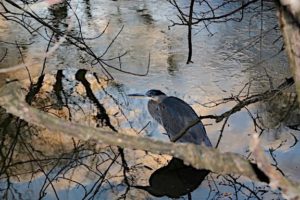
A Winter Hour Pondside
The city had withdrawn into itself
And left at last the country to the country;
…between whirls of snow not come to lie
And whirls of foliage not yet laid…
Opening of “Christmas Trees” by
Robert Frost
By Fred Bouchard
WALK DOWN Beacon Street from Coolidge Corner alongside the westering winter sun. The sidewalk flattens out at James and St. Paul Streets. Cars and trams zip by; strollers nod and smile—so smile back. By the Holiday Inn, scruffy saplings are still dropping leaves. As the dome of Temple Ohabei Shalom looms and giant oaks stretch alongside brick residences, angle across Amory Street to the gentle swell of an oak-girt knoll, and peer over the split-rail fence and abandoned tennis courts at walkers tossing their terriers sticks and socializing. Now look up and listen… as another tiny adventure begins…
 House Sparrows flit noisily between the Amory homes and knoll fence. Fall’s fledglings, now grown, join their elders in serious foraging, no time for plaintive cheeping. Grey Squirrels skitter among the oak trunks, bury the last of the acorns, dig them up from the grasses, or just whine from upper branches.
House Sparrows flit noisily between the Amory homes and knoll fence. Fall’s fledglings, now grown, join their elders in serious foraging, no time for plaintive cheeping. Grey Squirrels skitter among the oak trunks, bury the last of the acorns, dig them up from the grasses, or just whine from upper branches.
A Great Blue Heron squats, a solitary sentinel at the pond’s edge. A grey-backed Snapping Turtle, dazed and logy, pokes his snout out from the scummy cedar-oiled depths. Open water attracts waterfowl, not just local Mallards and Canada Geese, but seasonal migrants like Hooded Mergansers. Perhaps Wood Ducks will take to their nesting box this season.

The “usual suspects” make their presence heard: deedling chickadees, inquisitive titmice, twittering goldfinches, nagging nuthatches. Robins and Mockingbirds, once migratory, have since the 1960s assured their presence year-round by acquiring a taste for winter berries: ilex (holly), cornus florida (dogwood), aronia (chokeberry), crataegus (hawthorn). Surprise hardy robins and Eurasian Starlings (even grackles) as they forage in loose flocks in the uplands or stalk the ball-field, heads cocked for grubs and worms that surface in thaws.
Find moments to enjoy the flora: wispy sedum, Winter Rose, pale green switches of Witch Hazel; in the Formal Garden purple kale and Japanese Maple. Pathside flowers peek out—tiny white asters, dried faded goldenrod, snowdrops—all of them there through assiduous replanting efforts. At the bridge, tall, waving, plume-like phragmites harbor hardy over-wintering Song Sparrows. An occasional chipmunk pops her head from her tree-root den, and White-throated Sparrows lurk in the brush.

Bugs, too, are abroad in cold months. Winter Moths—an invasive exotic pest, nearly as destructive in some neighborhoods as the Gypsy Moth —may rest on tree trunks; only the beige-striped males can fly. You might also find the Winter Firefly, Snow Flea, Snow Scorpionfly, and Snow Cranefly hopping about on snow patches or branches. Their first names are apt, but neither sex can fly!
Stroll through the upland pines for evidence of owls: slender gray or ruddy Screech Owl or chunky, browneyed Barred Owl may adorn trunks with streaks of whitewash and cough up pellets containing mice and vole bones. On a dusting of snow, seek out spoor— tracks (paw prints) or scat (poop)—of rabbit, squirrel, Red Fox, or Wild Turkeys. You may catch sight of raptors cruising the canopy for prey: hefty pale Red-tailed Hawk for squirrel, or slender, agile Cooper’s Hawk or Merlin for unwary songbirds (passerines).
O ye Brookliners! Go stretch your legs with Mother Nature even on taut gray wintry mornings.
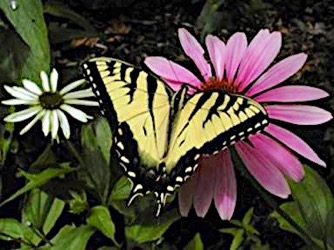
From the Co-Presidents
Ellen Forrester and Frank Caro
BOTH of the Friends spring and fall community days were great successes this year. We enjoyed spectacular weather in May and again in October. On both occasions, we had a variety of activities ranging from traditional sanctuary and garden clean-up chores to bird walks, tours of the Sanctuary, and live music provided by John Harris and Happy Dance. Best of all we had a great deal of participation from people of all ages.
Another highlight was Ginna Johnson’s talk at our annual meeting about the Conservation Commission’s plans for horticultural improvements in the Sanctuary.

We continue to draw on generous contributions of our members to pay for ongoing horticultural improvements. In the formal garden, where we are updating many plantings, an emphasis is to introduce more plants that attract bees and butterflies. In Nan’s Meadow, we continue to add native grasses. Along the paths just outside the formal garden, we are adding spring-flowering native woodland plants. We encourage you to renew your membership and consider making a larger contribution! If you are not yet a member, please join us!
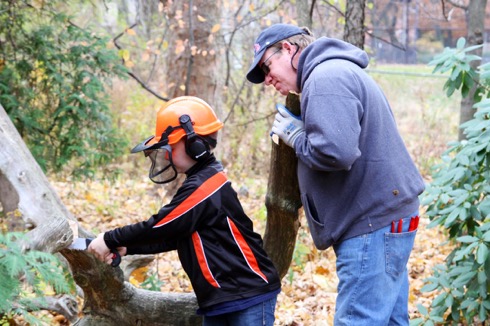
From the Conservation Commission
By Tom Brady, Conservation Administrator
I CONSIDER MYSELF very fortunate to have the opportunity to work with the Friends of Halls Pond over the past fifteen years. The collaboration between the Town and the Friends is a model of thoughtful and successful partnership. As we wind down the fall season and begin our transition to winter, now is a perfect time to reflect on what has been accomplished and what issues will need to be addressed in the 2018.
This past year has been a vibrant and busy time for the sanctuary. The Friends have had two enormously successful workdays, and Frank Caro and his crew continue to provide a tremendous amount of loving care and upkeep to the sanctuary throughout the season. Their work gives a boost to the efforts to control the ever-advancing invasive species on the site.
This year a landscape master plan was also developed by the Town in partnership with the Friends to provide a guiding document for future planting and restorative efforts for the sanctuary. Ginna Johnson was the lead on this plan, and we are thankful for her efforts. This plan has already been put into action and will serve us well for many years to come.
As is the normal practice, the major maintenance and upkeep has continued throughout the year using Town staff and contracted services. Items addressed include tree pruning and removal, regular mowing of the formal garden areas, maintenance of the sediment forebay which protects the pond from harmful sediment, drainage improvements to control and mitigate runoff that may affect the sanctuary, and repairs to fences and entrance gates enclosing the sanctuary.
In Brookline as a whole we have a new insect of concern. The Emerald Ash Borer is an aggressive insect that targets and kills ash trees due to damage caused by its extensive boring. In the coming year we will be placing traps in the ash trees at the sanctuary to monitor for this aggressive pest.
The Brookline Conservation Commission is fortunate to have such an active and thoughtful group to partner with as we both work to care for this precious resource.
The Brookline Conservation Commission is fortunate to have such an active and thoughtful group to partner with as we both work to care for this precious resource.
Birding: Attention, Observation, Reflection
By Neil Gore

SHERLOCK HOLMES once asked Dr. Watson: How many steps lead up to our suite of rooms? When Watson was unable to answer, Holmes said, “You have not observed. And yet you have seen.” This story illustrates a pitfall of birding and nature study. It is easy to be caught up in disappointments (Q: Did I see a Northern Waterthrush at Hall’s Pond in 2017? A: No); and to overlook more rewarding perspectives.

“The river is never twice the same.” And no two days of birding are ever exactly the same. It is easy to recall unique and striking events. At Hall’s
Pond I once saw six brilliantly colored male Rosebreasted Grosbeaks feeding on a small leaning tree at an intersection of the boardwalk trails. Neither the tree nor the birds are there now. My only
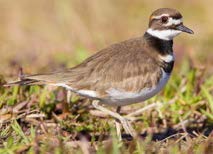
sighting of Killdeer was several years ago when a few briefly landed on the Amory field grass —Killdeer sometimes will nest along the edges of athletic fields—but after assessing the hubbub of dogs, dogwalkers, cars, and people for 45 seconds, they moved on.

Non-events can also be memorable. I have not seen or heard a Carolina Wren at Hall’s Pond for several years. Previously it seemed they were extending their range northwards, even over-wintering sometimes in or after mild winters. It is great fun to locate: A little bird with a big voice, which presents a satisfying “Where’s Waldo?” level of challenge to actually spot—and they are in the vicinity.

Autumn can be a time to reflect on changes. Immersing oneself in the world of birds and birding—which luckily can be easily done without immersing oneself in the great depths of Hall’s Pond itself!— can be a gratifying way to focus our attention, cultivate our observational skills, and reflect on life itself.
And maybe we’ll have a Barred Owl visit Hall’s Pond again, like last fall and winter. Let us know at Sightings if you can find anything of interest!
PHOTOS BY SHAWN P. CAREY, MIGRATION PRODUCTIONS
(not at Hall’s Pond)
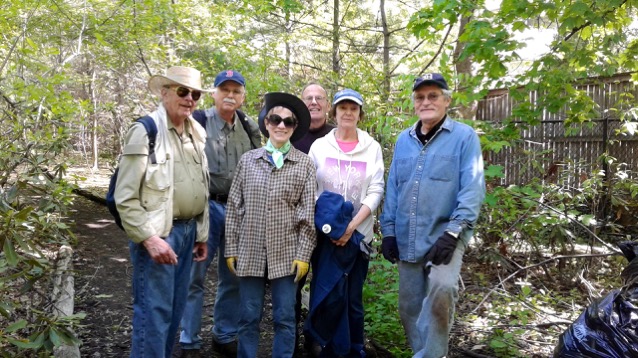
bending, and stretching to remove invasives.
L to R: Bruce Wolff, John Shreffler, Deborah
Stone, Frank Caro, Alex Beck, and Neil Gore. (Photo Credit Fran Perler)
Volunteer Maintenance Team
By Frank Caro

OUR VOLUNTEER maintenance team continues to be active throughout the growing season. The team grooms the formal garden and controls invasive species throughout the Sanctuary. The team holds scheduled sessions twice a month, and supplements the work done by the larger number of volunteers who participate in the spring and fall Community days.
In the formal garden, we have continued our emphasis on deep pruning of established shrubs to open up more space for herbaceous plants. The emphasis on planting bee and butterfly attractors continues. The Agastache (anise hyssop) that we planted last fall proved to be particularly striking. We continue to plant more Asclepia (butterfly weed).
Luckily, the garden benefited from good rain in May, June, and July, but in late summer, we needed to do some extensive watering. We refreshed the bedding plants in mid-summer to compensate for the damage done by hungry rabbits.
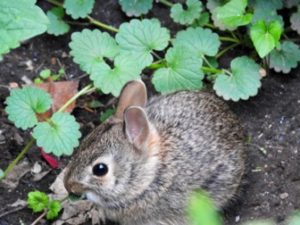
In the Sanctuary, our efforts over the past several years to control invasive vines have been successful. Invasive vines that climb high up into the trees are now rare.
Our core group of volunteers this year consisted of Priscilla Smith, Janet Wynn, Neil Gore, Helen Herman, Fran Givelber, and newcomer John Shreffler. Others who contributed included Bruce Wolf, Fran Perler, Betty Goldstein, Alex Beck, Mary Klatt, Bob Schram, Assunta Cha, and Deborah Stone.
We welcome newcomers whether they come frequently or only occasionally. We provide equipment and on the- job training to new volunteers. Don’t be intimidated by that phrase—in five minutes, someone will explain what’s needed and how to do it, and people often work in pairs on the same task. We find light work for those who want it.
Because most of our volunteers are retired, most of our sessions are held on weekday mornings. However, next year we will add more weekend sessions in the formal garden and meadow if there is sufficient demand, and we intend to announce dates for our work sessions well in advance so that volunteers can reserve the dates on their calendars. If you’re intrigued, contact Frank Caro, Volunteer Coordinator at frank.g.caro@gmail.com or 617-739-9228.
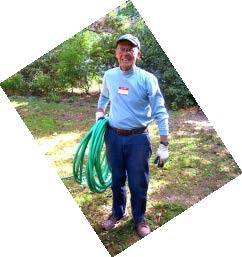
Frank Caro, the organizational energy behind the Maintenance Team, Community Day, and more, finishes up the day by making sure all the equipment gets back to the shed. (Photo Credit Deborah Stone)
Scenes from Fall Community Day
A hearty shout out to the crew of fifteen 8th graders from Devotion School who planted native grasses, ferns and Turtle’s Head, and did many other tasks. Their participation in our Community Days is becoming a tradition, thanks to the eighth grade parents who encourage their kids to do community service and look for opportunities. This fall, the group was coordinated by Charla Whitley, the Eighth Grade Activity Organizer, and last spring, a similar group led by Deborah Fung provided invaluable help.
The Sightings Project
by Deborah Stone
THE IDEA for the Sightings page on our website came from the trees. Trees, it turns out, are highly social beings. They communicate through airborne scents called pheromones, through their roots and through underground networks of fungal threads.
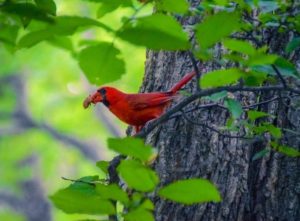
Trees act much like we do when our immune systems deploy antibodies. A tree sends warnings about predators— say, a caterpillar chewing its leaves—so that other trees in the area can deploy chemical deterrents or call in beneficial predators who will make short work of the offending predator. Forest trees also nourish each other and care for their sick and injured, much as we do when we love our friends and families. A tree stump can live hundreds of years even though it no longer has leaves to photosynthesize sugars for itself. The secret? Nearby trees feed the stump by passing nutrients from their roots to its roots.
So what has all this got do with Sightings? The project is a way for people who love Halls Pond Sanctuary to communicate about it and nurture it. On the Friends of Halls Pond webpage, there’s a tab at the top right called “See & Share Sightings.” There, people can post sightings, comments, questions, photos, and reflections about the sanctuary. It’s easy to use and you can click on any photo to see a larger view.
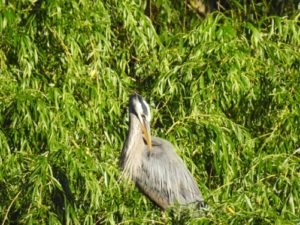
about half an hour I watched the Great
Blue Heron sit, stretch and preen on its
favorite dead branch mid-pond until it
flew up into the willows on the south
edge, where it continued its preening.
From Sightings, June, 2017. (Photo Credit Deborah Stone)
The Sightings page lets us share what has delighted us on a recent visit, or perhaps, like the trees, send warnings about something that seems to be threatening the sanctuary’s health. Did you see an unusual bird? Did you see a Great Blue Heron catch a fish so big it had to carve it up in order to swallow it? Did you come upon bunnies playing? Did you notice a delicate yellow Trout Lily, or a field of purple violets? Were you amazed by the willto- live of an old willow tree? Did you overhear a toddler enthralled by a goose and catch some of her magic? Whatever it was, don’t just keep it to yourself. Tell the rest of us, so we can look for it, too.
The Sightings Project is meant to awaken our senses, open us to surprises, and help us notice more as we stroll around the sanctuary. The more you know what’s possible to see and the more you hope to see, the more you will see. Even if you don’t see what you’re looking for, your attention will “bring” you something unexpected.
information about trees from The Hidden Life of Trees by Peter Wohlleben, whose family name means “good living” and whose book helps us do just that. The URL for our website is: friendsofhallspond.org. Laura Schneider, the Friends’ web guru, moderates the page and clears all posts before they go public.
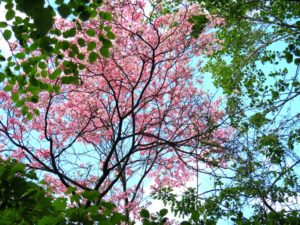
There’s a beautiful pink Dogwood tree, located in the little strip of woods to the east of the “arcade” that connects the formal garden with the pond area. The tree is so crowded that it has had to shoot up above the canopy and has no lower branches, but it’s worth craning your neck. From Sightings May, 2017.
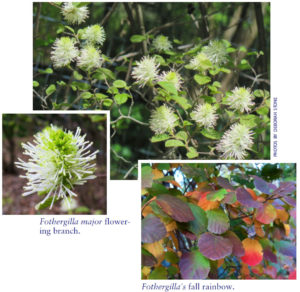 In the Formal Garden: Fothergilla
In the Formal Garden: Fothergilla
By Ellen Forrester
The Fothergilla pictured here is one of the highlights of the formal garden. Enough cannot be said about this native shrub. It comes in a few varieties and sizes making it a great plant for the shady urban home garden. The smaller Fothergilla gardenii (dwarf fothergilla) has a height and spread of 3–4′ and the larger Fothergilla major “Mt Airy” (Mount Airy fothergilla) is 5–6′ in height and spread. Both of these plants have a fragrant, bottlebrush-style white bloom. The flowers blossom before the plant leafs out and provide a necessary early season nectar source for bees and butterflies. In summer these shrubs are a nice backdrop to the garden with great shape and leathery leaves. In fall, the exceptional colors of its yellow, orange and red leaves really make the garden come alive. This pest and disease resistant shrub is best used in a grouping to provide maximum benefits.







